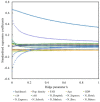Correlations between the urban built environmental factors and the spatial distribution at the community level in the reported COVID-19 samples: A case study of Wuhan
- PMID: 35975194
- PMCID: PMC9372090
- DOI: 10.1016/j.cities.2022.103932
Correlations between the urban built environmental factors and the spatial distribution at the community level in the reported COVID-19 samples: A case study of Wuhan
Abstract
COVID-19 has dramatically changed the lifestyle of people, especially in urban environments. This paper investigated the variations of built environments that were measurably associated with the spread of COVID-19 in 150 Wuhan communities. The incidence rate in each community before and after the lockdown (January 23, 2020), as respective dependent variables, represented the situation under normal circumstances and non-pharmaceutical interventions (NPI). After controlling the population density, floor area ratio (FAR), property age and sociodemographic factors, the built environmental factors in two spatial dimensions, the 15-minute walking life circle and the 10-minute cycling life circle, were brought into the Hierarchical Linear Regression Model and the Ridge Regression Model. The results indicated that before lockdown, the number of markets and schools were positively associated with the incidence rate, while community population density and FAR were negatively associated with COVID-19 transmission. After lockdown, FAR, GDP, the number of hospitals (in the 15-minute walking life circle) and the bus stations (in the 10-minute cycling life circle) became negatively correlated with the incidence rate, while markets remained positive. This study effectively extends the discussions on the association between the urban built environment and the spread of COVID-19. Meanwhile, given the limitations of sociodemographic data sources, the conclusions of this study should be interpreted and applied with caution.
Keywords: Built environmental factors; COVID-19 spatial analysis; Community level; Hierarchical Linear Regression; Ridge regression.
© 2022 Published by Elsevier Ltd.
Conflict of interest statement
We declare that we have no financial and personal relationships with other people or organizations that can inappropriately influence our work, and there is no professional or other personal interest of any nature or kind in any product, service and/or company that could be construed as influencing the position presented in, or the review of, the manuscript entitled “Correlations between the urban built environmental factors and the spatial distribution at the community level in the reported COVID-19 samples: A case study of Wuhan”.
Figures








Similar articles
-
How did COVID-19 case distribution associate with the urban built environment? A community-level exploration in Shanghai focusing on non-linear relationship.PLoS One. 2024 Oct 16;19(10):e0309019. doi: 10.1371/journal.pone.0309019. eCollection 2024. PLoS One. 2024. PMID: 39413079 Free PMC article.
-
Modelling Impact of High-Rise, High-Density Built Environment on COVID-19 Risks: Empirical Results from a Case Study of Two Chinese Cities.Int J Environ Res Public Health. 2023 Jan 12;20(2):1422. doi: 10.3390/ijerph20021422. Int J Environ Res Public Health. 2023. PMID: 36674175 Free PMC article.
-
Distribution of COVID-19 Morbidity Rate in Association with Social and Economic Factors in Wuhan, China: Implications for Urban Development.Int J Environ Res Public Health. 2020 May 14;17(10):3417. doi: 10.3390/ijerph17103417. Int J Environ Res Public Health. 2020. PMID: 32422948 Free PMC article.
-
The impacts of the built environment on the incidence rate of COVID-19: A case study of King County, Washington.Sustain Cities Soc. 2021 Nov;74:103144. doi: 10.1016/j.scs.2021.103144. Epub 2021 Jul 10. Sustain Cities Soc. 2021. PMID: 34306992 Free PMC article.
-
Identification of the high-risk residence communities and possible risk factors of COVID-19 in Wuhan, China.J Saf Sci Resil. 2021 Jun;2(2):31-39. doi: 10.1016/j.jnlssr.2021.04.001. Epub 2021 Apr 24. J Saf Sci Resil. 2021. PMID: 40477207 Free PMC article.
Cited by
-
Mechanisms influencing the factors of urban built environments and coronavirus disease 2019 at macroscopic and microscopic scales: The role of cities.Front Public Health. 2023 Feb 28;11:1137489. doi: 10.3389/fpubh.2023.1137489. eCollection 2023. Front Public Health. 2023. PMID: 36935684 Free PMC article.
-
An analysis of the spatio-temporal behavior of COVID-19 patients using activity trajectory data.Heliyon. 2023 Oct 9;9(10):e20681. doi: 10.1016/j.heliyon.2023.e20681. eCollection 2023 Oct. Heliyon. 2023. PMID: 37867866 Free PMC article.
-
Effect of urban structure, population density and proximity to contagion on COVID-19 infections during the SARS-CoV-2 Alpha and Omicron waves in Málaga, Spain, March 2020 to December 2021.Euro Surveill. 2025 Jan;30(3):2400174. doi: 10.2807/1560-7917.ES.2025.30.3.2400174. Euro Surveill. 2025. PMID: 39850003 Free PMC article.
References
LinkOut - more resources
Full Text Sources
